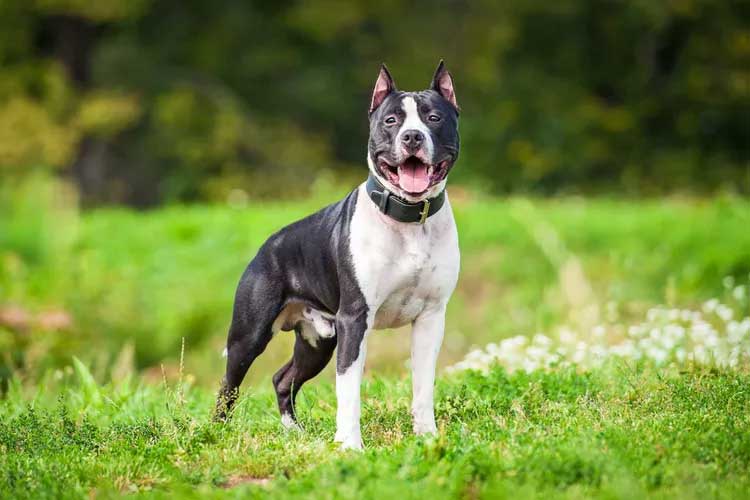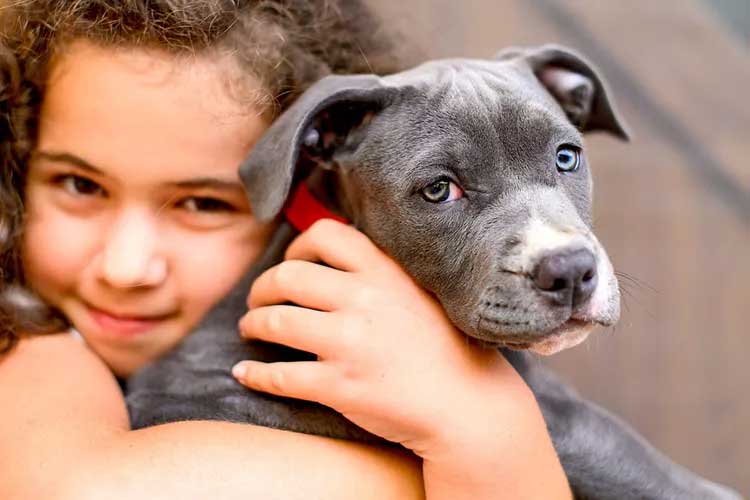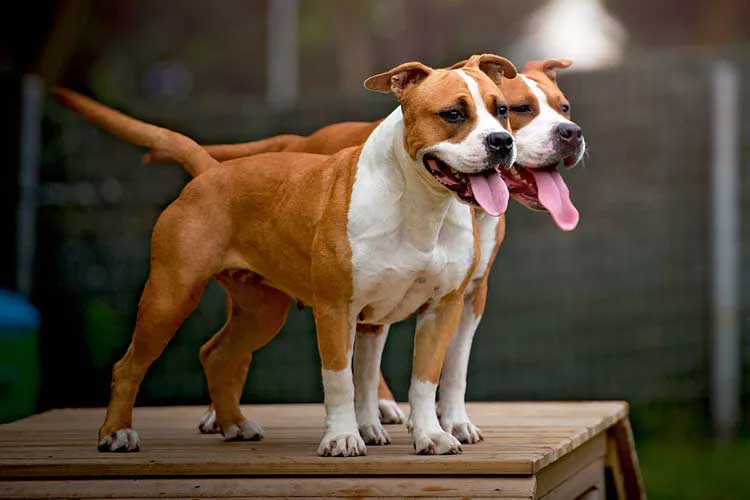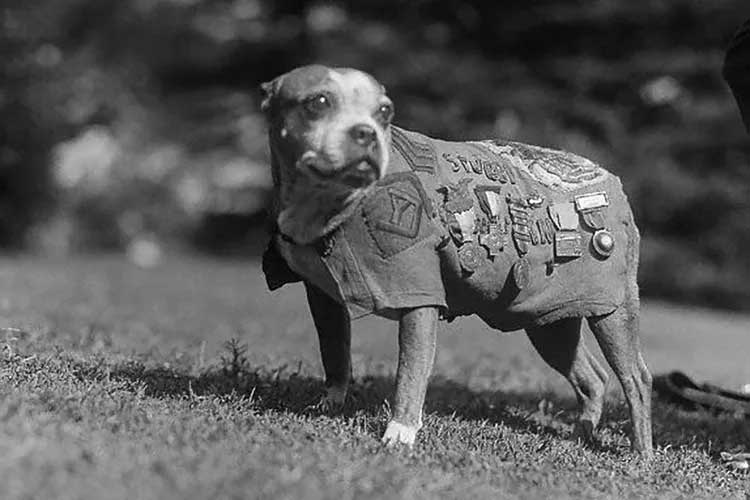Courageous, smart, and loyal, the American Staffordshire terrier (“AmStaff" for short) can be a wonderful family pet that learns quickly with positive reinforcement. These energetic dogs are always up for a good outdoor adventure with their human friends.

American Staffordshire Terrier Overview
| OFFICIAL NAME | American Staffordshire Terrier |
| COMMON NAME | American Staffordshire Terrier |
| PET HEIGHT | 17 to 19 inches |
| PET WEIGHT | 60 to 80 pounds |
| LIFESPAN | 10 to 15 years |
| GOOD WITH | children, families |
| TEMPERAMENT | friendly, outgoing, playful |
| INTELLIGENCE | high |
| SHEDDING AMOUNT | infrequent |
| EXERCISE NEEDS | medium |
| ENERGY LEVEL | active |
| VOCAL LEVEL | frequent |
| DROOL AMOUNT | medium |
| BREED GROUP | terrier |
| BREED SIZE | medium (26-60 lbs.) |
| COAT LENGTH | short |
| COLORS | black, blue, brown / chocolate / liver, fawn |
| PATTERNS | brindle, sable |
| OTHER TRAITS | easy to groom, hot weather tolerant, strong loyalty tendencies, tendency to chew |
Stocky but sweet-natured American Staffordshire terriers—"AmStaffs" to their friends—are muscle-bound softies who form fast, strong bonds with their humans. Excellent lookouts and loyal companions, they have lots of energy and a playful streak—they're always up for a run or a good game of fetch or Frisbee in the yard.
American Staffordshire terriers are stocky and muscular dogs with sometimes more energy than they know what to do with—and they need a job and activities that work their strong bodies. For many years, these traits were exploited to turn AmStaffs into fighting dogs or bull baiters. But when properly trained with positive reinforcement and continually socialized, American Staffordshire terriers can be terrific family pets who are as gentle and trustworthy as they come.
Appearance
Built like fuzzy fire hydrants, American Staffordshire terriers top out around 19 inches tall, but pack a solid 40–70 pounds of muscle on those small frames. This gives the AmStaff an unmistakable presence, with their thick, muscular necks, barrel chests, and slender hindquarters.
AmStaffs come in a variety of colors, with liver, sable, brindle, and brown being the most common, often with some white on their heads and chests. Their stiff, glossy coats are short with no undercoat, making them easy to care for, but also more sensitive to cold temperatures.
They have broad, intelligent faces, usually with dark-colored eyes, though blue is an occasional exception. Their tails are short compared to the rest of their body, tapering to a point.
Temperament
OK. So, elephant in the room: Yes, the American Staffordshire terrier has a history as a dog bred for fighting. Despite the stigma around this breed, many individuals and families find the AmStaff to be a great multi-purpose dog that excels at all sorts of fun dog sports.
AmStaffs are intelligent dogs—they understand cues well and are very trainable. However, due to their size and quickness, they require a handler who keeps them mentally and physically stimulated. Be sure to provide your American Staffordshire terrier ample opportunities for enrichment and the chance to enjoy training, exercise, and games that put their brain—and body—to work. This is not a breed that will be happy with just a short walk around the block or one training class in their life. It's also for this reason that first-time owners might want to look elsewhere.
"If anything, I'm subtly steering [first-time owners] away from them," says Dennis Riordan, DVM, of Riordan Pet Hospital in Des Moines, Iowa. "If you go to any shelter, the majority of the dogs you're going to see have those [Staffie] traits, partly because people don't realize there are breed-specific restrictions [and have to surrender their dogs because of those restrictions], and partly because they can be a lot for a new dog owner to handle."

AmStaffs can make great playmates and can do very well with children, but they do enjoy a much more rambunctious play style. Coupled with their heavy, stocky build, it can make them a bit much for smaller children to handle. Similarly, their size and strength can make them freight trains on a leash when they have not been taught to walk nicely. As with all dog breeds, kiddos should be supervised when playing with any individual dog.
AmStaffs need daily exercise and mental stimulation to keep them from getting bored. And keeping them from getting bored is going to be a priority for any owner, because a bored AmStaff will chew on shoes, furniture, or whatever else he can get his paws on. Keep plenty of chew toys around!

But their drive and muscular frames make them ideal dogs for lots of fun activities including dock diving or agility games, and the breed has even excelled when trained for search and rescue operations. Their stoic nature and resilience makes them a natural fit for physically demanding work.
"My dad loved pit bulls and Staffordshire terriers because they were such courageous, stoic dogs," Riordan says.
American Staffordshire terriers are dogs that will bark a healthy amount, especially if they are bored or left alone for long periods of time, and they are blessed with loud, deep voices. It's important to consider teaching your AmStaff to offer other behaviors, like go-to-mat, by reinforcing those more desirable behaviors in place of barking.
Living Needs
You're going to need a fenced yard. This is not a dog that will typically do well in an apartment because there simply isn't enough space for them to frolic. These dogs are also excellent jumpers and climbers, making them adept escape artists—so you should never leave them alone in your backyard. The AmStaff loves being with his human, and when left unattended he may develop separation anxiety or dig up your yard out of boredom.This breed traditionally doesn't do well with other dogs. Exceptions can be found when American Staffordshire puppies are socialized at an early age, but your AmStaff might still do best if he's the only dog in the house.
Care
Easily the simplest part about owning an American Staffordshire terrier is caring for an American Staffordshire terrier. Their single-coat fur is short and slightly oily, preventing it from retaining dirt and making them resistant to burrs and matting. They are very light shedders, requiring little to no brushing. Similarly, the oils in their hair keep them from developing any of the traditional "dog odors," meaning that bathing will need to happen only on an as-needed basis, rather than on any kind of regular time table.
Like all dogs, their nails will need regular trimming, their teeth should be brushed, and they need regular ear cleanings, too.
Health
The American Staffordshire terrier is a generally healthy dog breed. They are, however, prone to skin allergies, urinary tract infections, and some autoimmune diseases. Hip dysplasia and elbow problems are also relatively common, according to the Staffordshire Terrier Club of America (STCA).Additionally, it is recommended to get your AmStaff tested for cerebellar ataxia, a condition that can result in a decline in muscle coordination and that usually manifests between the ages of three and five.
History
The American Staffordshire terrier has undeniable ties to the bloodsport dogs of 18th and 19th century England. These dogs were commonly bred to fight or released in packs to challenge bulls for the amusement of crowds, according to the STCA. It's from this formidable dog that breeds like the American Staffordshire, the bull terrier, and the modern English bulldog all draw lineage.The American Staffordshire terrier was developed from the original bulldog (a very different animal from today's English or American bulldogs). What other dogs were used in cross breeding is a murkier river to trace, but it is believed that now-extinct breed such as the white English terrier or the black and tan terrier were used to create the Staffordshire terrier, according to the STCA.

Those Staffordshire terriers made their way to the U.S. by the 1850s, where American breeders developed a version that was larger and heavier than the English Staffordshire, which the American Kennel Club recognized as a separate breed in 1936.
Fun Facts
American Staffordshire terriers have long been popular in American culture. Petey, the scrappy dog from the Our Gang films of the 1930s, was an AmStaff.A drug-sniffing AmStaff named Popsicle became famous for sniffing out one of the largest cocaine busts in US history. In Texas, he found a ton and a half of cocaine with a street value of $139,605,000.
A dog named Stubby was the most decorated dog of World War I, climbing to the rank of Sergeant. He warned soldiers of gas attacks, survived 17 battles, and is thought to be an AmStaff mix.